The long way to make a drawing and the hidden meaning of small disturbances
Jens Hoffmann about Reiner Schwarz
Many things can be recognized right away: a chair, a wheel barrel, the pot with glue, the car. Others, like tools, fruits, headless rocking horses take time. What they have in common you get only in hindsight. They are drawn, with charcoal and color pencils, heightened with white, on paper. " From the outset drawing means to distance oneself from the face of nature, drawing means to "abstract" from nature. "(1) Doodles of little men and the house of Santa Claus are made with lines. The line is the essence of a drawing. The line, whether it circumscribes the form of an object, defines the surface, or the volume through shading, forces abstraction. But this kind of abstraction is nearly absent if you look at the drawings of Reiner Schwarz: no such lines to be found. But these drawn "pictures" must be seen and analyzed as drawings too, in order to understand their relationship with the concept of a "drawing". Usually grabbing pencil and paper is the quickest way to sketch an idea visually. At the end of the 14th. century paper replaces the until then common parchment, which allows for a wider distribution and, due to the usually smaller sizes, handling becomes easier. The drawing (the artist drawing, not the technical, architectural or other types) is often seen as "the freest and most personal of all arts"(2), in which the style of an artist can be recognized best. Most of the time such drawings are spontaneous and relaxed, strokes are like searching, the lines enclose the object, at least sketch the contours. Very often the supposed easiness, with which these drawings came about is remarkable. One stroke may enthuse and solely define the quality of a drawing. The quick sketch of an idea, to be developed further, is the classic domain of the artist drawing. It was the Italian Renaissance during which the artistic and documentary quality of drawings became valued. Still the content was secondary, to be developed with the help of more drawings like detail or layout sketches. Abstract, or even drawings without any pretense of an "object" offer the eye only points, lines and shapes, which are the elementary tools of drawing. For this reason it is supposed, that "in a drawing the focus isn't at all what, but how it's done."(3) For sure this is true considering such detail and layout sketches, which as a part of an artistic project define the way that starts with the first idea and ends as a sculpture, a piece of architecture or print graphics. These drawings are not supposed to be final at all, they are not seen as the final piece of artwork. Though the most likely oldest of all arts (think of the scraped line drawings at stone age cave walls) drawings were the last the arts to be freed from its mainly servant function.(4) Not until the 19th. century the drawing became recognized as an autonomous piece of art, that is to reach the status of a separate (classic) form of art. Autonomous or not, the question "how" they were created, remains, though the striking realism of the drawings we are talking about distracts from the technical aspect. All too quickly you find yourself confronted with well known content that asks for not (not that easy) to be withhold comment. What you see, seems to be what you get and this invites discussion, without any obvious necessity to reflect on formal aspects. The drawings of Reiner Schwarz are large, compact, concentrated. Defining lines are not to be found. No hatching and no wipes, though the use of charcoal ask a maximum of mental alertness in order to avoid them and frequent fixation of the material. Schwarz slows the often speedy art of sketching, his drawings aren't spontaneous at all. They are the outcome of a rigorous creative process, built on the recognition of an object able to stimulate a dialog and to carry an idea. Instead of sketches Reiner Schwarz uses photography, sparing him sketches of details. But for this reason, those photos must already preserve "his" view at the object. This way the most traditional function of an artist drawing is replaced completely. The drawing itself stands at the end of the creative process, it switches from a supporting role to main actor. With short strokes, linked without starting point or end, Reiner Schwarz leads us into the inner structure of his drawings. This net of of strokes - rather "shoved" than drawn - creates the selected object anew, there is barely a line to separate spaces or to define borders. None that describes or outlines, giving hints to other ends. By no means the goal is to copy what you can see or what just happens to happen in nature ("natura naturata"). Instead the hunt goes for the essence of things ("natura naturans"), in order to visualize what you can't see. These short strokes create an organism, an object in its own right or another existence of the viewed object as a drawing. This other existence presents itself sharp and crisp, but allows for blurs too, this way feeding not only the intellectual but also the emotional experience. That is, if you look from a distance. Close-up even details blur, but this puts the "texture", the structure that makes the drawing, into focus: Reiner Schwarz' "concept of drawing". A weave of black scribbles, layered with aspects of color and heightened with white, never trying to fool the eye, instead always presenting itself as a drawing. The fascination of a drawing as a drawing, its obvious technical character thus becomes striking. Apart from more linear drawings, this difference of impression of close-up views and viewing from a distance, puts these drawings rather aside the art of painting. Their "making" does not copy reality, but constitutes a reality of its own, made with charcoal and paper. Reiner Schwarz works mostly on brown paper, packing paper produced in the former GDR. It shows a warm, light brown tone, darkens easily and in other lighting its tone varies from gray to gold. The specialty of this paper is its size and unevenness. Because it's made by compression of various material you may still find readable newspaper pieces in it, glittering aluminum scraps or sometimes even little but intact pieces of wood. Thus the paper always remains uneven and wavy. Stuff that's to heavy or to big may fall out, leaving little holes, which is against the original function of this type of paper: Packing paper is meant to enclose, that is to wrap or hide. Schwarz spreads this paper, reaching sometimes sizes that even for paintings would be considered to be large. This is his arena and a second form of existence for this kind of paper too. Such, this paper becomes the perfect base for Schwarz's new sights of things, able to stand for itself, if the layout of the artwork is well defined. Furthermore, implementing such "empty" spaces, Schwarz helps the viewer to grapple with the possibility of virtually finishing the drawing with his own imagination, to look at it from his own point of view and to explore it himself. Reiner Schwarz transfers the, in a formal sense, typically "fragmentary" character of a sketchy linear drawing into these empty spaces. Two times the same glass vase, the same flowers. One time on a reflecting base, in front of an uneasy background that defies definition. The other time right on the plain paper, within the space of the paper so to speak, which is actually created by the spatiality of the flowers itself. But this impression also results from the physical characteristics of the paper, which shows all but a smooth surface. The flowers shown to be standing on a surface have to withstand the imposing background. Less detail enhances their appearance and makes them, especially the red one, more colorful. But they are stuck to the composition though their background is quite undefined, because their spatial relation to this background is not: You can't remove them from a spatial framework, which they are part of. The "free" standing flowers show more detail, more internal structure, in the calyx (black) and in the glass vase (white, red). They are more self defined, stand better for themselves and it is easier to think of them being in a space of their "own", they "fit". It is a new concept of drawing, created on paper used against its original function. With sometimes large sizes and due to the tremendous precision (though it is done with charcoal, that can be wiped easily), that is all in all with conditions for drawing made harder, Reiner Schwarz presents things that are emptied and used up, deranged or shut down, not used for the moment or unusable. Removed from their usual environment, isolated but "open", open to be integrated into a new context, to be brought into new intellectual and emotional relations. The original function of these things, that may have been till then the dominating if not the only aspect of their being, becomes less important. Schwarz preserves this state of non-function, in which no duty calls them (anymore) and time is not significant (anymore). Such he gives his objects, that are freed from being forced to function, the chance to find their up to this point hidden qualities, that is to say, these qualities can be explored now. A space for visual perception emerges, the created object can build a (new) relation with the viewer, or more likely: The viewer can find a (new) relation towards the object. Neither beauty, nor the ugly becomes aestheticized, the same is true for the normal. Often it is the insignificant, sometimes the special. Reiner Schwarz guides your view towards the special within the common and makes the unimportant special. How far reaching that can be, he shows in an impressive way, if you look at the stages in his work "Life Cycles". Again gone, antiquated things reappear, he brings them back and he repeats them. The view at one object, something to sit on, a body rest, a thing able to support a persons weight, becomes not just doubled, but quadrupled. Four times the same view at the same arm-chair, but four different impressions, for ways of looking at it, "mutations" if you want. One time it is a cozy place for cuddling, though fragile in a way that asks for caution. The next time you get the impression of hideous canyons, of fissures with unknown depth. This easy-chair shows no wish to support our body anymore, it looks too "selfconcious". It does not wish to carry our weight, it wants to be carried and wants to tell his story. Another object presents itself from viewpoint that looks casual, cropped at three sides and shown in nice colors, a vehicle to play with or to just push it, you may look at it with the eyes of a kid. But the next moment its true figure is unveiled: crossways and much closer now the bier stands in front of a black wall, a definite border. Up to this point the path for movements, like the way of drawing may have had a certain openness, but this has come to an end, for everybody and final. The color is gone, its wheels seem to convey the pallor of death, in a way ready to move them. If one of the biers presents itself as an contemplative object, the other tends towards showing a more abstract graphic face. Less realism, more of the formal graphic structure of drawing dominates the emotional perception. Innocuous the view if you start from the bottom, delicate wheels with thin spokes. But looking from the front or from above, the deep black and the massive stripes that block everything, seem to push the viewer into the grid of these spokes (heightened with white they look even sharper): so you feel hopelessly captured. The way Reiner Schwarz tries to alter and to expand the conscious perception of his creations, his new objects, the same way he alters and expands his chosen artistic means for these creations: Schwarz defines his technique, his means, his shapes and sizes with the same consistency he shows drawing. Having redefined and changed the art of drawing itself, he is right in saying, that he is no "draftsman". But he makes "drawings" and how he does!
Jens Hoffmann (translation B.D.)
(1) Wolf Stubbe: Geschichte der
zeichnerischen und druckgraphischen Techniken, in: Das goldene
Buch der Graphik, Braunschweig 1974, S. 6.
(2) Eduard Trier: Zeichner des XX. Jahrhunderts, Berlin 1956,
S. 9. Vgl. auch hier nicht zitierte Werke zur Künstlerzeichnung,
z. B.: Otto Fischer: Geschichte der deutschen Zeichnung und Graphik,
München 1951; Heinrich Leporini: Die Künstlerzeichnung;
Braunschweig 1926; Jean Leymarie, Genevieve Monnier, Bernice
Rose: Die Zeichnung, Entwicklung – Stilformen – Funktion,
Stuttgart 1980; Joseph Meder: Die Handzeichnung, Ihre Technik
und Entwicklung, Wien 1923.
(3) Walter Koschatzky: Die Kunst der Zeichnung, München
1981, S. 14.
(4) Heribert Hutter: Die Handzeichnung, Entwicklung, Technik,
Eigenart, Wien 1966, S. 6.
(5) Koschatzky, a. a. O., S. 20.


Die Schubkarre 1992
"The wheelbarrel"
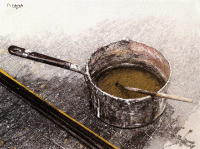
Der Leimtopf von Olaf Lemke 1994
"The glue pot of Olaf Lemke"
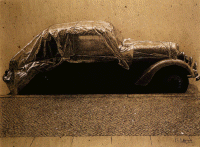
Das Auto 1988
"The car"
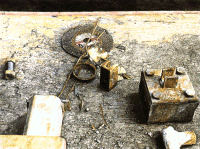
Stilleben auf Werkbank, I 1992
"Still life on workbench I"
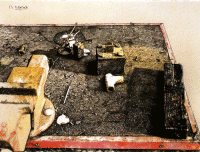
Stilleben auf Werkbank, II 1993
"Still life on workbench II"
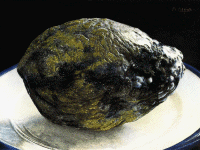
Die große Papaya 1992
"The large papaya"
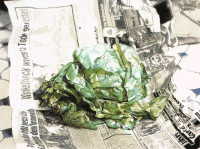
Der große Salat 1991
"The large salad"
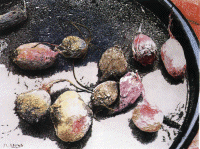
Rote Beete 1995
"Red beets"
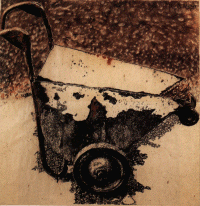
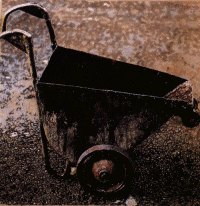
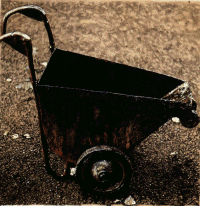
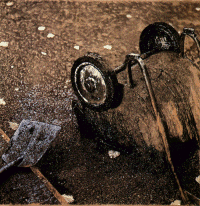
Lebenszyklus: Teerkarren 1989
"Life cycle: tar carts"
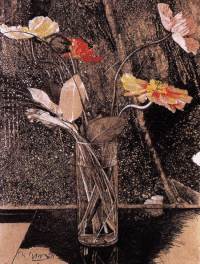
Mohn 1996
"Poppy"
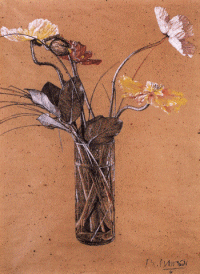
Mohn 1996
"Poppy"
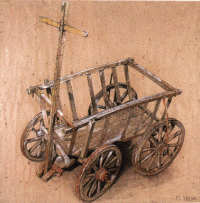
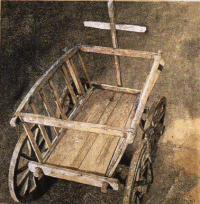
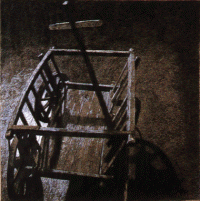
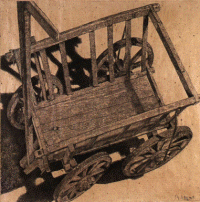
Lebenszyklus: Handwagen 1990
"Life cycle: handcarts"
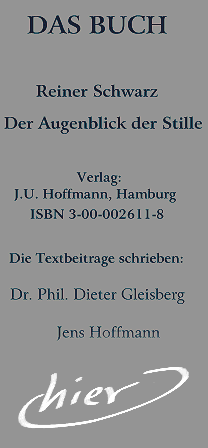
|
Jens Hoffmann born 1964 in Nürnberg, lives in Hamburg/Germany
His main topics are: Italian architecture and sculpture of the 15th. and 16th. century, Spanish painting and graphics in the 17th. and 18th. century, German drawings in the 20th. century. At the moment he is writing about the early drawings of Goya. |